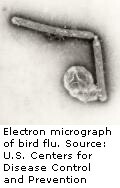
THURSDAY, June 21 (HealthDay News) — As few as five mutations are enough to make the H5N1 avian influenza virus transmissible via airborne droplets between ferrets, according to a new, highly anticipated report.
Because the flu virus affects ferrets and humans in a similar way, the new findings, appearing in the June 22 issue of the journal Science, may shed light on how likely it is that an avian or “bird flu” virus will become pandemic and spread rapidly between humans.
If a new virus emerged, humans could essentially be defenseless against it.
The paper is the second of two whose publication was banned by the U.S. government, which feared that publishing specifics on a sequence of the H5N1 bird flu might prompt bioterrorists to develop and unleash a pandemic.
In April, however, the controversial ban was lifted and the first paper was published in the journal Nature.
Bruce Alberts, the editor-in-chief of Science, speaking at a press conference Wednesday, said he hoped publication of this and a companion paper “will help to make the world safer by stimulating more scientists and policy makers to focus on preparing defenses [against a pandemic].”
Asked whether the report might increase the chances that a rogue scientist would be able to replicate the work, Dr. Anthony Fauci, director of the U.S. National Institute of Allergy and Infectious Diseases, said he thought “the benefit of the paper in stimulating thoughts and in stimulating ways to better understand [the virus] far outweighs any nefarious use of the information.”
In order to understand how avian flu viruses could become airborne in mammals, the authors of the first Science study first introduced three mutations thought to increase the ability of the virus to spread between mammals into an existing strain of the H5N1 virus.
The virus was then put in the nose of ferrets. Researchers then swabbed the virus from the ferret’s noses and introduced it into another set of ferrets, and then another — tracking all the time how the virus evolved.
After 10 of these “passages,” the virus had acquired the ability to transmit via aerosol or respiratory droplets.
In total, five mutations gave the virus the ability to spread through the air. This included the three initially introduced by the researchers, plus two more that evolved on their own while the virus was passing from ferret to ferret.
The airborne virus did not, however, kill the ferrets, said study co-author Ron Fouchier, of the department of virology at Erasmus Medical Center in the Netherlands.
And the antiviral drug Tamiflu (oseltamivir) was effective against the new strain of virus in the ferrets.
A second paper in the same issue of Science found that two of the mutations needed to make the virus spread between mammals already are seen frequently in combination with each other in nature, meaning as few as three additional mutations might be all that is needed to result in a virus similar to the one constructed in the first paper.
Researchers don’t know at this point how likely it would be for all these mutations to occur in a single host, said co-author Derek Smith, professor of infectious disease informatics at the University of Cambridge in England.
Taken together, the Nature and the new Science papers showed different ways viruses can change to potentially infect humans.
The earlier paper showed that mutations plus reassortment (when genetic information from more than one species is mixed) produced transmissibility, and, indeed, this fit with long-held theories that such reassortment would be necessary for a pandemic to occur.
But the current paper showed that mutations alone were sufficient.
“We can get a transmissible virus by mutation only and by a combination of mutation and reassortment,” Fauci said.
More information
The U.S. Centers for Disease Control and Prevention has more on bird flu.

